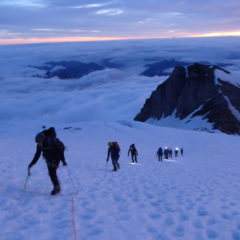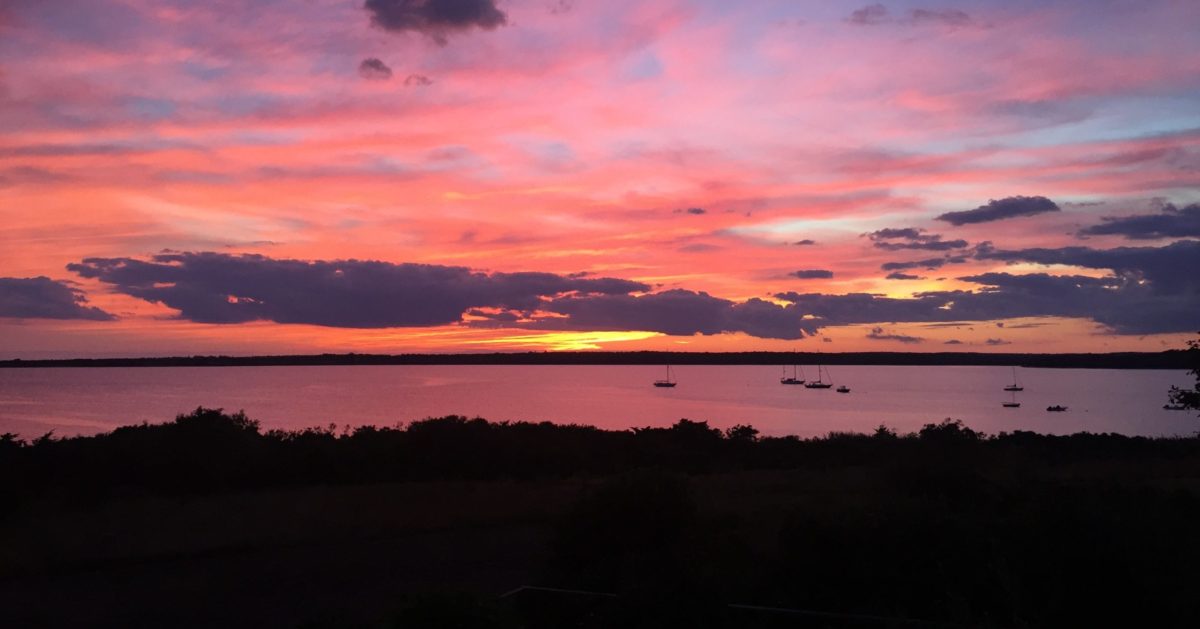It is finally happening and I am on my way to Nepal. Jill dropped me at Logan airport last night and I flew 12 hours to Doha, where I am currently ensconced in an elegant transfer lounge awaiting my flight to Kathmandu. A neat feeling of transition: three years of hard training and preparation behind me, the entire Everest expedition ahead of me, and a chance to reflect on what brought me here.
The final weeks passed in a blur. Despite carefully allowing for all that needed to get done before heading off for two months, the amount of details still surprised me. And I kept training hard right up to the end.
A week ago today, I did a final hike in the White Mountains with Will. It was something we have both long wanted to do: a traverse of the Presidential Range in winter conditions. Among dedicated hikers and mountaineers, the traverse is well known and respected. It covers 19 miles, 14 of them above treeline, crosses 7 of the highest summits in the Northeast, and climbs almost 9,000 vertical feet. Many people do it over two or three days. Some try to do it one day. And some try to do it in one day in winter, which is what we did.
We started hiking at 4:00am. By sunrise, we were on the summit of Mount Madison. The sky was totally clear and the winds were minimal. It just doesn’t get any better up there. We spent the day high on ridge lines and summits, with jaw dropping views in all directions, and finished around 6:00pm. It was wonderful to descend the final ridge, emerge from the woods, and find Jill waiting for us at the trailhead with the car. She had been tracking our progress on our satellite beacon.
In many ways, this day was all that I cherish in the mountains: exhilarating beauty, physical challenge, spiritual connection with nature, and the reward of shared experience.
Here is a photo of Will about a quarter of the way into it.
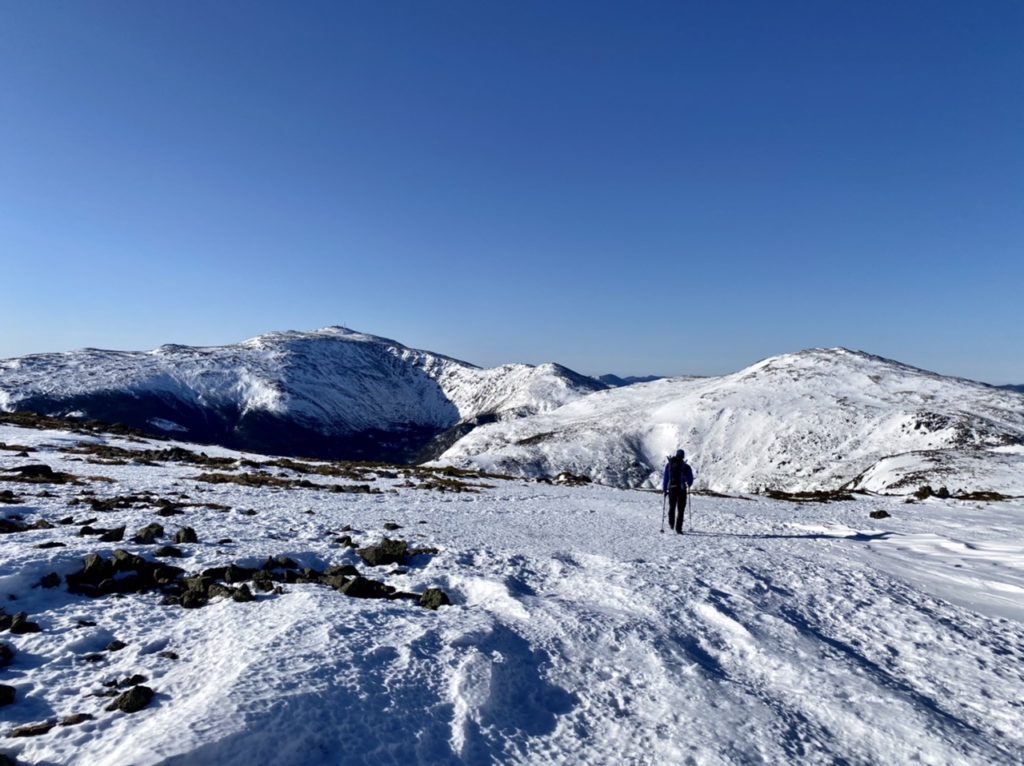
All the Everest prep I have been doing would have been worth it if the only thing it did was get me in shape for last Monday.
So, why Everest?
George Mallory provided the definitive answer in 1923, in three words. I started dreaming of it over 50 years ago. My father owned an outdoor sports store, staffed with avid climbers and full of mountaineering books. I spent long hours sitting on the store floor, reading accounts of the great climbing expeditions of the 1960’s and 1970’s.
On the wall in my bedroom growing up was a poster. I wrote about it last spring when my original Everest climb was cancelled. Those of you who read about it then should feel free to skip ahead several paragraphs. For those of you who didn’t, here is a photo of the poster again. Its title was “Everest: The West Ridge”.
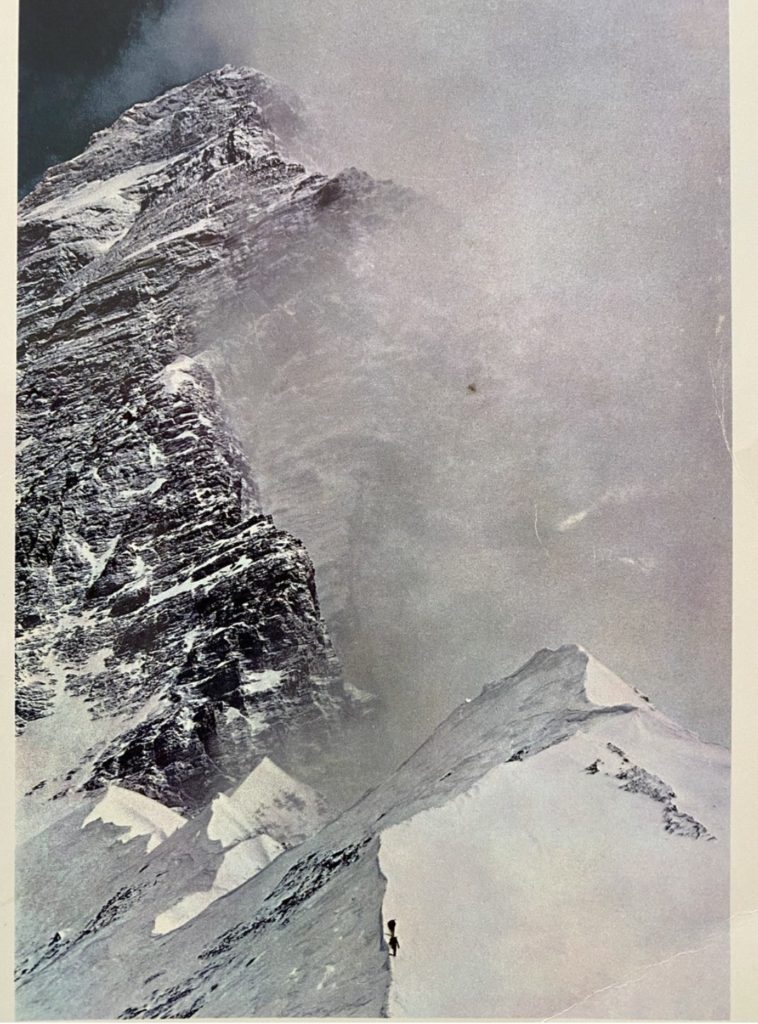
The small figures at the bottom of the photo are Tom Hornbein and Willi Unsoeld, two American climbers who made history in 1963 with their epic first ascent of the west ridge. That is the ridge towering above them: 9,000 vertical feet of technically challenging terrain, at extreme altitude, that no one had ever set foot on. Hornbein and Unsoeld ascended the ridge, traversed the summit, miraculously survived a night bivouacked high on the mountain, and descended the southeast ridge safely the following morning, (ultimately with a few less toes).
As striking to me as the photo was the quote at the bottom of the poster, a paraphrase of Goethe attributed to Scottish mountaineer W.H. Murray :
“WHATEVER YOU CAN DO, OR DREAM YOU CAN, BEGIN IT. BOLDNESS HAS GENIUS, POWER, AND MAGIC IN IT”
The combination of that photo and quote stuck with me; one of those childhood impressions that shape how you approach the adult world. It still does.
Willi Unsoeld, one of the climbers in the photo, found in climbing an intense blend of physical and spiritual satisfaction. A couple of great biographies have been written about him. He was also a friend of my father’s. The first time I went climbing, in the early 1970’s at Den Rock in Andover MA, Willi was at the top of the rope.
And here is another poster that lodged in my consciousness. It was on the dorm room wall of several friends back in college. I loved both the photograph and also what the title connoted: “top of the world”!
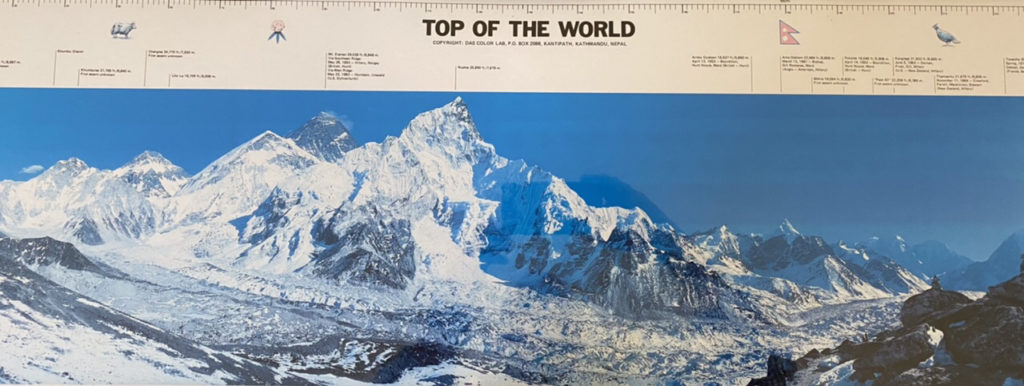
In our first year of marriage in 1990, Jill and I spent several weeks trekking in the Everest region. I climbed alone up to the location where the poster photo was taken, as I’ll bet a number of people reading this blog have also done. My walk back down the valley to rejoin Jill was one of the most intensely memorable hikes of my life: walking alone through clear January air, surrounded by all that beauty.
When we got back to Kathmandu, Jill bought me a copy of the very same “top of the world” poster as a present, and it has been on the wall of our master bathroom ever since. On a daily basis for the last thirty years, I have looked at it and wondered “am I ever going to climb to to the top of the world, or am I going to spend my whole life just wondering what it would have been like?” By the way, Everest base camp is located on the far left side of the photo. I will be walking back up that valley in a couple of weeks.
How my thinking on Everest has evolved
Sitting on the floor of my Dad’s shop reading climbing books as a ten year old, the Willi Unsoelds of the world were super heroes, and the only people who set foot on Everest and the other Himalayan giants were the climbing elite. Regular people lacked both the climbing pedigree and political connections to get on expeditions, and climbing permits were rare and coveted items. Physical features on Everest like the Khumbu Icefall, Lhotse Face, Geneva Spur, The Balcony, and Hilary Step were like features on the moon; something you could read about and picture in your mind, but that you would never actually set foot on.
In the late 1980’s, in a trend well covered by Jon Krakauer in “Into Thin Air”, the advent of commercial guiding began opening up the Himalayan peaks to regular people. Shortly after climbing Denali with three close friends in 1992, I remember realizing that “wow, there actually are Everest expeditions out there that I could get on!” I was very close to going on one of those expeditions in 1995, (the year before the “Into Thin Air” events), until another close friend explained how stupid it was for someone at my life stage, with two young children at the time, to take that kind of risk. He was right, and I backed out.
I got busy with a business career and being a father, and climbing faded into the background. I climbed a few things, but Everest wasn’t on my radar screen, especially with the mountain attracting more and more people as the commercial climbing industry continued to grow. My mindset evolved to: “Everest was a dream in its time, but it has gotten to a place that the experience wouldn’t be what I have long been picturing. And, while I am at peace with a lot of the risks one takes on the mountain, I REALLY don’t want to die stuck in a bottleneck of climbers at the Hilary Step. If I want to climb a big Himalayan peak, there are plenty of other candidates.”
This was my mindset right up to a few years ago, when I started to do more climbing again. I talked with lots of guides who know Everest intimately, and they uniformly said the same thing: Everest remains magical, and the image created in the press of overcrowding and overuse – while having a basis in reality – is a long ways from the full picture. For many of the climbers and guides I spoke with, Everest remains their favorite overall climbing experience.
So my thinking about Everest evolved yet again, to something like: “It isn’t the experience that Willi Unsoeld had, but it still is Everest. Screw all the negative press, and the fact that elements of it have changed with time. There is still something magical about following in the footsteps of all those expeditions I read about in my youth , and something magical in pursuing long held dreams.”
That is some of what has gotten to me to this point. I am mindful of the realities of the modern Everest, both negative and positive, and am simultaneously thrilled and grateful to be doing this. The whole thing strikes deep emotional chords.
My flight to Kathmandu boards shortly. Here I come!
